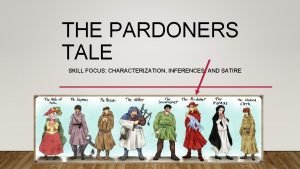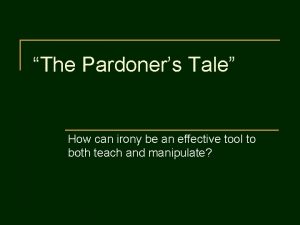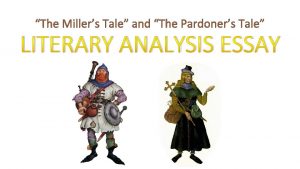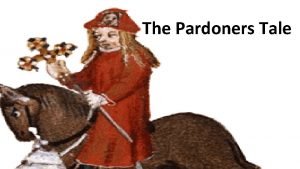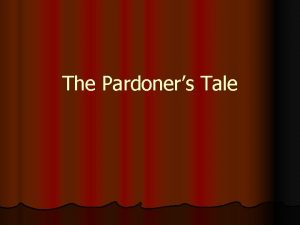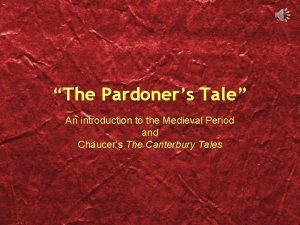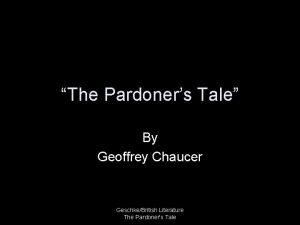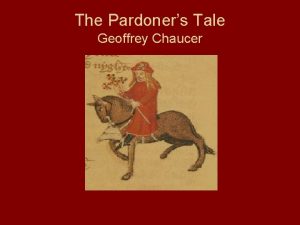The Pardoners Tale The Pre Tale Section The













- Slides: 13

The Pardoner’s Tale

The Pre Tale Section • The Pardoner tells the travelers • Whenever he preaches his theme is always • “That greed is the root of all evil” • He brags openly and boldly • of his corrupt practices and manipulative methods of getting money out of the gullible. • how little he cares for humanity.

• He also states that he enjoys the creature comforts humanity‘s guilt and stupidity afford him. • The terrible man is also aware that he preaches against what he himself practices. • He launches his story by remarking that his wickedness does not prevent him from telling a moral story.

The Tale • Early one day, three very depraved and evil companions are drinking together in a tavern. • These young men have been totally ruined by the sins of gluttony, avarice, and sloth. • The three hear a bell ringing for a funeral, and a boy tells them that a friend of theirs has been killed by a thief called Death.

• The tavern keeper says this fellow, Death, has slain a whole village about a mile from there. • The three drunks pledge to find Death and kill him before nightfall. • They head out for the town the tavern keeper mentioned. • Shortly, they meet a very old man who points them to an oak tree where he says they will meet Death.

• Off rushes the obsessed trio, but when they reach the oak tree, it is bushels of gold they find there. • All thoughts of Death leave them as they plot to get the money back to their own village. • The young men draw straws to see which of them will go back to the town for food and drink to sustain them during the day while they guard their treasure.

• The youngest of the three draws the short straw; he sets out for the town at once. • As soon as he is gone, the other two conspire to murder him when he returns, so they can keep the wealth all for themselves. • In the meantime, the youngest one has determined to kill the other two. He buys strong poison in the town and adds it to the wine he buys for his companions.

• As soon as the youngest gets back with the supplies, the two companions pounce on him and murder him. • They then sit down to drink and celebrate, but die immediately when they drink the poisoned wine.

Post Tale • This story is followed by another sermon against avarice and the beginning of a sales pitch for the relics the Pardoner carries. • The Host interrupts. He refuses to go along with any more of what he perceives as the Pardoner's duplicity and sacrilege and says so very coarsely. • The Pardoner becomes infuriated at the Host's insults and the Knight has to intervene. • He insists that the two kiss and make up, which they do.

What Does it Mean? • The wicked practices of the Pardoner were, unfortunately, widespread in the medieval Catholic Church. • However, the Pardoner is so openly and gleefully and unashamedly wicked that he himself serves a sermon against these practices. • His tale is totally in keeping with his character.

• The form of The Pardoner's Tale, an allegory, is one with which medieval audiences would have been completely familiar. • In an allegory • the characters personify abstract qualities • the plot is meant to teach a moral lesson.

n In this case, Avarice, Gluttony, and Sloth meet Death at their own hands; in other words, these vices lead invariably to spiritual death.

• This particular allegory had many versions in Eastern and in Western literature and was frequently enacted as a morality play. Therefore, it is not attributed to any single source. • Chaucer's version is the one that has survived. It has become one of the most widely read and best loved of The Canterbury Tales.
 Satire in the pardoner’s tale quiz
Satire in the pardoner’s tale quiz Irony in the pardoner's tale
Irony in the pardoner's tale Osnowa dokumentu
Osnowa dokumentu Folk tale characteristics
Folk tale characteristics Caesarean section ppt
Caesarean section ppt Revolved section drawing
Revolved section drawing Define a revolved section view?
Define a revolved section view? Section lining symbols
Section lining symbols Work and energy section 2 describing energy
Work and energy section 2 describing energy Study guide chapter 10 section 1 meiosis
Study guide chapter 10 section 1 meiosis Hát kết hợp bộ gõ cơ thể
Hát kết hợp bộ gõ cơ thể Slidetodoc
Slidetodoc Bổ thể
Bổ thể Tỉ lệ cơ thể trẻ em
Tỉ lệ cơ thể trẻ em
